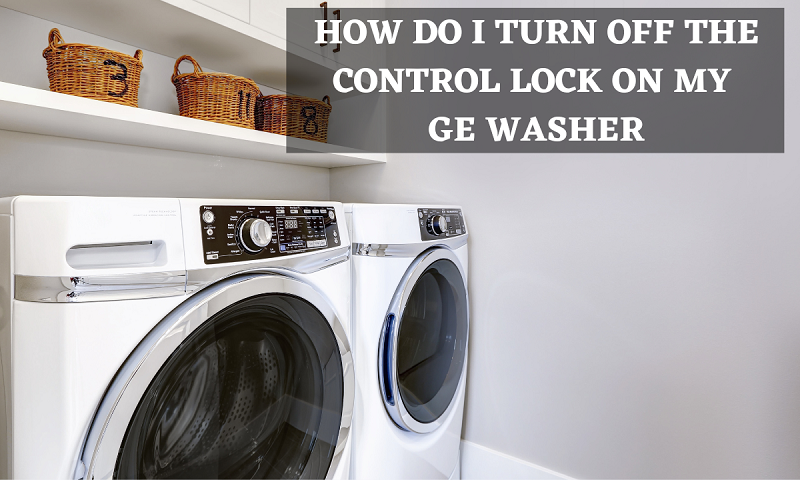When you initiate a wash cycle, the first thing your washing machine does is the filling of water in the wash tub. According to the wash cycle, the water is filled in the tub with the help of water inlet valves. But sometimes, the washer starts to fill initially but stops midway without appropriately filling the tub as per the wash cycle and load.
GE washers can also encounter this issue due to several reasons. In this article, we will understand the different reasons and troubleshooting tips for a GE washing machine to start filling with water and then stop.

GE Washing Machine Starts to Fill and Then Stops
Your GE washing machine starts to fill and then stops midway due to the following reasons:
- Water inlet taps are closed
- The water inlet hose filter is blocked
- The lid is not closed properly
- The lid switch is faulty
- Failure of Load sensors
- Failure of Water inlet valves
- Excessive Suds
Water Inlet Taps are Closed
Whenever you find your washer to stop filling midway, you must first check the taps. Most of the time, the taps might be closed and because of this, your washer stops to fill. Initially, the water starts to fill because there might be some residual water present in the water line which will pour into the tub. But once the water in the line is emptied, the washer stops.
Troubleshoot:
- Check your water inlet taps and ensure that they are open. If you find them to be closed, open them.
- After opening the water taps, start the wash cycle. Because the GE washer might have paused when the water stopped to fill.
The Water Inlet Hose Filter is Blocked
If you find your water taps to be open and still the washer is not starting to fill, then you have to check the hose filter. The water inlet in the washer has a hose screen that filters the debris and dust. This filter can easily get blocked and it can prevent the water from flowing into the washer tub. This can also cause the washer to start filling initially and then stop.
Troubleshoot:
- Pause the wash cycle in the washer
- Turn off the water inlet taps
- You can find the water inlet of the washer at the backside
- Remove the water inlet hose from the hot and cold water inlets
- Once you remove the hose, you can find a small filter in the inlet
- Remove the filter and clean it with running water
- Replace the clean filter and fix the hose back into the inlet
- Open the taps and check whether the washer starts to fill
The Lid is not Closed Properly
GE washers cannot function if the lid is not closed properly. The lid has a switch that contacts the control board when it is engaged properly.
If the lid is closed completely, the switch is closed and the wash cycle starts. But when the lid is not closed completely, the switch is open and the washer cannot start functioning.
Initially, the lid switch might have had some connectivity and this started the washer to fill with water. But afterward, the lid switch connectivity is lost which causes the filling to stop.
If you are new to using the washing machine, know that the lid must be closed for the wash cycle to start.
Troubleshoot:
- Check whether the lid is closed completely
- If the lid lock has some debris obstructing the lid from closing, it must be cleaned and removed
- After cleaning the lid lock, close the lid and ensure that it is locking completely
The Lid Switch is Faulty
Sometimes the lid switch might be actually faulty and this causes the washer to fill with water, then stop abruptly. You can find the problem with the lid switch when you cannot close the lid properly. The lid may magnetically attach to the washer but it will not close the circuit with the switch due to the fault in the lid switch.
Troubleshoot:
- If you find the lid switch to be faulty, you must replace the GE washer lid switch.
- You can find the right switch part for your washer model and use it to replace the switch
- Once you replace the switch and close the lid completely, you can find the washer to fill up with water properly.
Failure of Load Sensors
Load sensors or pressure sensors in a washer help in stopping the water inlet when the right volume of water is achieved in the tub. When there is an issue with the pressure sensor, this can lead to either overflowing of water or the GE washer won’t fill. You can find this failure with the help of error codes. The GE washer error codes can help you find out whether the sensor is faulty or not.
Troubleshoot:
- Check the washer display for the error code E62. This error code can indicate a shorted component such as the water inlet valve or pressure sensor
- When the water pressure is
- If you find this error code, you can stop the washer and try to check whether the sensor works properly.
- You can get the help of a technician and try to troubleshoot it properly
Failure of Water Inlet Valves
The water inlet valves are solenoid valves that actuate when they receive the electrical signal. If the valve is faulty, the GE washer fills with water but then stops. The washer doesn’t fill the tub with the proper water level because of the faulty water inlet valves.
Troubleshoot:
- Check for error codes in the washing machine using the test mode. If you find that the error code E62 is present, you can first check the water inlet valve and the water supply.
- Unplug the washer and remove the valve from the washer. Check whether the valve works under power. If it doesn’t actuate, replace the valve
- If the valve actuates, then there is an issue with the control board. You might need to contact a technician to fix the control board
Excessive Suds
The washer might be tricked into being full or overflowing due to the presence of excessive suds.
This problem usually happens during the rinse cycle where the washer tries to fill the tub with fresh water but stops intermittently due to the presence of suds.
When you use a different type of detergent for the washer then it can cause a lot of suds during the wash cycle.
These suds can take a lot of time to drain and start to overflow when fresh water fills up. Due to this, the washer will stop filling the water and prevent overflowing.
Troubleshoot:
- When you find excessive suds in the washer, you must wait until the suds drain completely
- In the top load washer, you can leave the lid open and let the suds settle down. In front load washer, keep the door locked and pause the cycle so that the suds settle down.
- Once the suds are settled, you can start the cycle again which will fill the water properly.
These are the different reasons for the GE washer to fill with water and then stop abruptly. You can follow this guide and troubleshoot the problem effectively.


